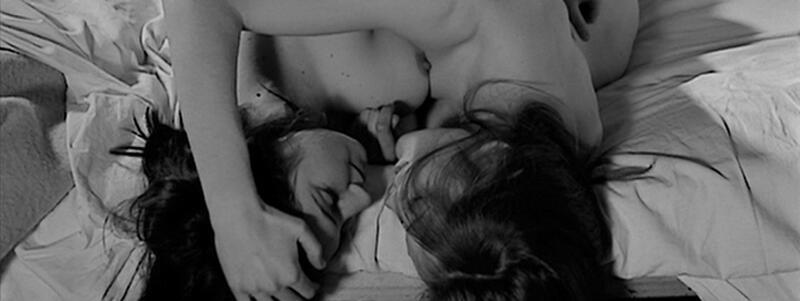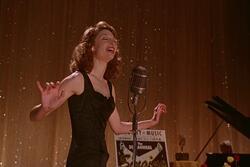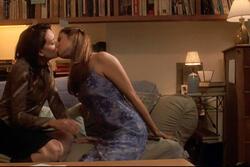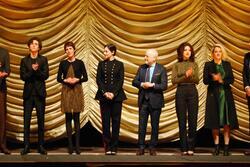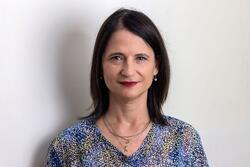Chantal Akerman’s Queer Jewish Cinema
The work of iconic post-war film director Chantal Akerman, who would have been 72 this month, has never been more timely.
Born in Brussels in 1950 to Polish Auschwitz survivors, Akerman was a radical feminist, lesbian, and Jew, though she mostly resisted such labels to avoid being stereotyped. Interest in depictions of queerness in her films has been muted, despite the fact that they are often transgressive in their unapologetic and at times intimate treatment of queer experience. And although LGBTQ+ representation in American film and TV is reported to be at a record high, Akerman’s work remains relevant at a time when queer communities continue to be marginalized on and off screen.
According to the annual “Where We Are On TV” report by the Gay and Lesbian Alliance Against Defamation (GLAAD), TV broadcasting in the 2021-2022 season included more LGBTQ+ representation than ever before, with 11.9 percent of prime time programs containing regular or recurring queer characters. The number of LGBTQ+ characters and their screen time also increased on the big screen, according to the organization’s film report for the same period, which explores queer representation across eight major studios. Importantly, the report noted a rise in LGBTQ+ characters of color.
Of course, we should celebrate media offering audiences more queer representation, especially when it's intersectional. Several recent films and TV shows grapple with being queer and Jewish in meaningful and entertaining ways—think Emma Seligman’s dark comedy Shiva Baby (2020), Amazon’s series Transparent (2014-19) and Luca Guadagnino’s film adaptation of André Aciman’s novel Call Me By Your Name (2017).
But representation alone isn’t a sufficient metric for evaluating the significance of heightened queer visibility on screen. The figures above don’t tell us about the persistence of harmful queer stereotypes, one-dimensional or “token” queer characters, the lack of queer writers and directors involved in productions, and the reception of these productions by queer communities. The numbers alone also don’t reflect the fact that, according to GLAAD, there were no transgender or nonbinary characters for the fourth consecutive year in film, while on TV, the number of queer characters with disabilities, as well as those living with HIV, has decreased.
This is where Akerman’s cinema and her treatment of queerness is distinctly valuable. Much of her work explores queer desire, relationships, and identity, in implicit and explicit ways. This is the case in films such as Les Rendez-vous d’Anna (The Meetings of Anna, 1978), in which the protagonist relays a sexual encounter with another woman to her mother, and her 1975 feminist film Jeanne Dielman, 23, quai du Commerce, 1080 Bruxelles, about a mother-cum-sex worker trapped in a patriarchal world of domestic labor.
Perhaps the most overtly queer film to emerge from Akerman’s career is Je Tu Il Elle (I You He She). It was released in 1974 and features the first-ever explicit lesbian sex scene in cinema. After I screened this film in a Queer Cinema class I taught last year, the students made two observations—first, that the film is challenging in its deliberate minimalism, slow pace, and lack of dialogue. And second, that it contains a uniquely intimate depiction of queer sex on screen—especially for its time.
Je Tu Il Elle is shot in monochrome and stars Akerman herself as the young and brooding Julia, the director injecting her own identity and Jewishness into the film. The first act follows Julia as she lounges in her apartment, methodically eating from a bag of sugar with a spoon, getting dressed and undressed, rearranging furniture, and drafting letters (to whom, we never find out).
While we get the sense in the first part of the film that she is socially isolated, the second and third acts portray Julia’s sexual encounters with two lovers—the first, a male truck driver she meets while hitchhiking, and the second, a former girlfriend.
With the trucker, Julia’s sexual exchange appears transactional and unromantic, interspersed with his reflections on cheating on his wife and sexualizing comments he makes about his young daughter.
With Julia’s ex-girlfriend, however, the atmosphere is entirely different. Shown in real time, the ten-minute-long scene is honest rather than romanticized, encapsulating the awkwardness of sex while refusing to shy away from representing queer sexual pleasure. It is also quiet, with no overlaid music—we hear only the breathing of the intertwined women, who hold one another with care and tenderness. With the camera remaining fixed in two different positions, we are afforded a view that is direct but not too close, preventing the kind of objectification of lesbian sex depicted in films like Blue is the Warmest Colour (2013). The outcome is a joyful, playful, and affectionate encounter. What matters here is less the status of Julia’s sexuality (is she bisexual, gay, or something else?), and more the unbridled quality of Akerman’s representation of queer sex.
Such representations are intertwined with Akerman’s Jewishness and feminism, both of which underpin all her work. “I’m a Jewish girl,” Akerman told French film theorist Nicole Brenez in a 2011 interview when asked to describe herself. And yet Akerman often relays this aspect of her identity indirectly, through metaphor. As film critic J. Hoberman writes, the filmmaker claimed that the monotony of domestic labor in Jeanne Dielman is about “lost Jewish rituals“, while the gray landscapes and expressionless faces shown in From the East (1993), set in the former Eastern bloc after the fall of the Berlin Wall, indirectly invoke the Holocaust and displaced Jewish identity. The palpable presence of Akerman’s mother Natalia (Nelly) in her work and the recurrent motif of mother-daughter relationships, as in Tomorrow We Move (2004), can also be read as distinctly Jewish.
The feminist undercurrent of Akerman’s work is perhaps easier to detect. The trucker’s monologue in Je Tu Il Elle presents a subtle critique of men’s patriarchal attitudes toward women, for instance, while Jeanne Dielman ends with the murder of the protagonist’s male client in defiance of her sexual and domestic oppression. A New York Times article from 1998 called Akerman’s films “powerful feminist documents” that center empowered women and pose important questions about the roles of women, female sexuality, and queer-Jewish-feminist identity.
Why, then, hasn’t Akerman’s work gotten more attention? According to an essay by scholar Madeline Ullrich , the answer might have something to do with the filmmaker’s avoidance of labels. It might also be related to the experimental nature of many of Akerman’s films, which could render them less accessible to the masses. Akerman was broadly inspired by European art cinema, and many of her films are in French (although subtitled versions are widely available). They are also often slow, repetitive, and set in claustrophobic domestic spaces, with strong themes of displacement that reflect Akerman’s claim that “I don’t feel that I belong anywhere.”
Akerman’s films might be challenging to watch, but that's an important aspect of their queerness. Her work is queer not only because it depicts queer encounters, but because it makes use of queer aesthetics and stylistic techniques that force audiences to engage with their content in a way that brushes up against the persisting heteronormative standard of cinema. Her contrived treatment of time in Je Tu Il Elle, for instance, gives viewers space to witness and reflect on the meaning and significance of queer sex acts on screen. Likewise, the monotony of Jeanne Dielman forces viewers to participate in the protagonist’s imprisonment and sympathize with her turning to sex work as a form of escapism.
Since Akerman’s death in 2015, numerous scholarly works have been published about her life and work, none of them engaging fully with the crucial stakes of her films as queer, Jewish, and feminist. Even in pop culture, her work has largely gone unnoticed. As contemporary queer representation rises for some groups, it’s essential that we keep asking what kinds of representations we are being offered. The liberated, feminist, and Jewish queerness that characterizes Akerman’s career offers us an important model.


